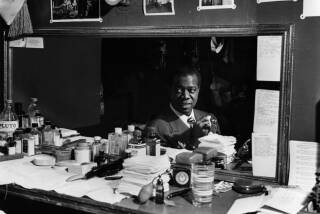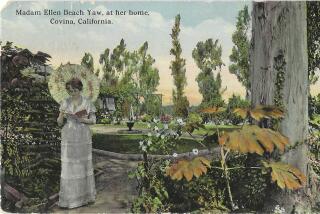Cab Calloway, Legendary Hi De Ho Man of Jazz, Dies : Music: Bandleader who was famed for his flamboyant stage routines suffered a stroke in June. He was 86.
- Share via
Cab Calloway, who dressed like the Taj Mahal, spoke like a hip Tower of Babel, and fathered the internationally beloved heroine of the song “Minnie the Moocher,” is dead, it was learned Saturday.
Calloway, who was 86, had suffered a severe stroke June 12 at his home in White Plains, N.Y., and died late Friday in the hospital unit of Cokesbury Retirement Village near Wilmington, Del. His family was at his side, said his wife, Nuffie.
A bandleader, singer, author and dancer, he had performed for more than six decades in the nation’s gaudiest nightspots, on Broadway and in films.
Although many modern critics found his musical machinations of marginal worth in an era of “cool,” erudite jazz, no one could dispute his entertainment value and the affection showered on him over the years.
He was the essential “Mr. Maestro” from the day he first stepped on the stage at Harlem’s famed Cotton Club during the Roaring ‘20s to his dazzling performance in the 1980 film “The Blues Brothers.” By that time he had come to epitomize the flamboyant Jazz Age.
Although a slight 5 feet, 8 inches tall, he appeared half a foot taller and pounds heavier in the white tuxedos with flowing tails that became his signature.
And he had a vocabulary to match his grandiloquent attire. Even if it did not make any sense.
Calloway was considered the father of “jive language,” even publishing a “Hepster’s Dictionary,” which became necessary if one were to translate spoken Calloway into understandable English.
He also came to be known as “King of the Hi De Ho,” a sobriquet that had its origins in his rendition of “Minnie the Moocher, the Lowdown Hootchie Kootcher.” As Calloway would complete each verse of the song he would chant, “Hi De Hi De Hi De Hi,” and the audience would respond, “Ho De Ho De Ho De Ho.” In performance, it became a much-anticipated ritual between entertainer and audience that became the favored point of almost all his concerts.
But Cabell Calloway III was not supposed to have spent his life singing the praises and phrases of loose women. He was supposed to have been an attorney.
He was the second of six children born to a Rochester, N.Y., attorney and his wife, and his parents had hoped he would follow his father into law. But an older sister, Blanche, had become a bandleader and singer in Chicago and in 1924, after graduating from high school, Calloway followed his sister to that jazz capital.
He did enroll briefly as a pre-law student at Crane College but that lasted less than a year. He had taught himself to play the drums and soon landed a job at the Sunset Cafe, where his flamboyant ways began to attract attention.
Within six months he was standing at the front of the stage rather than seated at the rear of the band. He was leading his first group, Cab Calloway and His Alabamians.
The band’s first booking, at the Savoy Ballroom in New York City, proved a flop and Calloway dissolved the group. He remained in New York however, taking a role in “Connie’s Hot Chocolates,” one of the all-black revues popular with white audiences.
His rendition of Fats Waller’s “Ain’t Misbehavin”’ was a high point of the show and Irving Mills, a well-known Broadway manager, took him under his wing.
Calloway also learned to play the saxophone and formed an orchestra that over the years came to feature such stellar jazz artists as Jonah Jones, Dizzy Gillespie, Leon (Chu) Berry, Cozy Cole and Ben Webster. Calloway’s talented and young ensemble became so popular it was given billing over Duke Ellington at the Cotton Club.
That celebrated den of iniquity was considered New York’s hottest entertainment spot. Opened in 1926 at 142nd Street and Lenox Avenue by former heavyweight boxing champion Jack Johnson (who sold it to a syndicate of mobsters), the club was the antebellum South in miniature.
The bandstand was a replica of a Confederate plantation home. It featured white columns and a backdrop on which were painted slave quarters set amid weeping willows.
Waiters wore red tuxedos like the butlers of the Old South and the tables were covered with red and white checked gingham tablecloths. And, of course, only whites were permitted in the audience.
Trumpeter Jones recalled those years and that setting in 1981, three years before the film “Cotton Club” was released with Calloway in a featured role. Jones told an interviewer that despite Calloway’s propensity for gambling away box office receipts, he never missed a payroll and also insisted on renting separate sleeping and dining cars for his touring musicians so they would not be subjected to the prejudice of white-dominated railroads.
Calloway did well at the Cotton Club and quickly moved from saloons to movie sets, appearing in such popular films as the first of the “Big Broadcast” pictures in 1932, “Stormy Weather,” “International House” and “The Singing Kid.”
By the late 1930s he was a millionaire earning $200,000 a year with band concerts and nightclub appearances, but that all ended after World War II when television began to keep people home in the evening. He made a few appearances on that infant medium, but in 1952 he returned to Broadway, where he had gotten his first big break.
The show was a revival of George Gershwin’s “Porgy and Bess” and Calloway was Sportin’ Life, the unctuous drug dealer. He moved back and forth between nightclub and legitimate theater stages, starring in 1961 with Pearl Bailey in an all-black production of “Hello Dolly” while appearing in “The Cincinnati Kid” and “The Blues Brothers” on screen.
In 1985, he toured the country with “Cotton Club Revisited,” a paean to his roots.
He married twice, had five daughters and seldom gave interviews, preferring to let his performing speak for him.
Even as he aged, the years never seemed to slow him down. He jumped about the stage, his hair flying wildly in a self-generated wind, charming crowds with his infectious smile.
After his marriage to Nuffie, his outside activities slowed considerably and they stayed together until his death.
The man considered the first of the scat jazz singers also wrote a rambling autobiography, “Of Minnie the Moocher and Me,” in which he counted up his gains and losses. Because of his gambling--particularly on the horses--there were a lot of the latter.
“They say I’ve had and lost millions of dollars. Buddy, they haven’t stopped counting yet,” he wrote in 1976.
“Women, horses, cars and clothes, I did it all. And do you know what that’s called, ladies and gentlemen? It’s called living.”
Too Hep
Some excerpts from “Cab Calloway’s “Hepster’s Dictionary,” 1944 edition:
Armstrongs: Musical notes in the upper register, high trumpet notes. (As in Louis Armstrong.)
In the groove: Perfect, no deviation, down the alley.
Kopasetic: Absolutely OK, the tops.
Pecking: A dance introduced at the Cotton Club in 1937.
Togged to the bricks: Dressed to kill from head to toe.
More to Read
The biggest entertainment stories
Get our big stories about Hollywood, film, television, music, arts, culture and more right in your inbox as soon as they publish.
You may occasionally receive promotional content from the Los Angeles Times.










